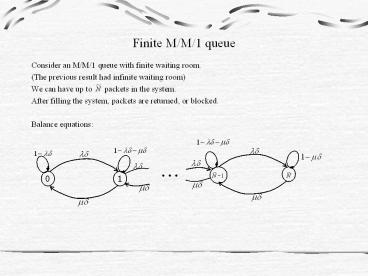Finite M/M/1 queue - PowerPoint PPT Presentation
1 / 19
Title:
Finite M/M/1 queue
Description:
After filling the system, packets are returned, or blocked. Balance equations: 0 1 ... M/M/ , M/M/m/m, and all other birth-death processes. – PowerPoint PPT presentation
Number of Views:17
Avg rating:3.0/5.0
Title: Finite M/M/1 queue
1
Finite M/M/1 queue
- Consider an M/M/1 queue with finite waiting room.
- (The previous result had infinite waiting room)
- We can have up to packets in the system.
- After filling the system, packets are returned,
or blocked. - Balance equations
0
1
2
- We have a steady state distribution for all ?.
Of particular interest is
3
- Consider any queue with blocking probability PB
and load ? packets/second. - Net arrival rate (1- PB) ?. Then ?
(1- PB) ? throughput. - From a different point of view,
system
4
- For M/M/1 queue of finite length,
5
M/M/m Queue
- There are m servers and the customers line up in
one queue. The customer at the head of the queue
is routed to the available server. - Balance equations
0
1
.
m1
m2
m-1
m
6
(No Transcript)
7
Erlang C Formula
8
M/M/? Queue
9
M/M/m/m/ Queue
- There are m servers. If a customer upon arrival
finds all servers busy, it does not enter the
system and is lost. The m in ///m is the
limit of the number of customers in the system.
This model is used frequently in the traditional
telephony. To use in the data networks, we can
assume that m is the number of virtual circuit
connections allowed. - Balance equations
.
m-1
m
0
1
10
(No Transcript)
11
(No Transcript)
12
Multi-Dimensional Markov Chain
- Consider transmission lines with m independent
circuits of equal capacity. There are two types
of sessions
13
Transition Probability Diagram
m, 0
m-1, 0
m-1, 1
. . .
. . .
. . .
1, m-1
1,0
1,2
1,1
. . .
0, m-1
0, m
0,2
0,1
0,0
14
- Suppose in the previous case, there is a limit k
lt m on the number of circuits that can be used by
sessions of type 1.
k,0
k,1
k, m-k
.
k-1, 2
k, m-k
k-1, 1
k-1,0
.
k-1, m-k-1
.
.
.
.
.
1, m-1
1,0
.
1,2
1,1
0, m
0, m-1
.
0,2
0,1
0,0
Blocking probabilities for call types
15
- Method of fining the steady state solutions for
multi dimensional Markov Chain.
16
Truncation of Multi Dimensional System
- Consider l M/M/1 in independent queues.
- Then, for the joint queue, the following is true
- Above is also true for M/M/m, M/M/?, M/M/m/m, and
all other birth-death processes. - We now consider truncation of multi dimensional
Markov Chain. Truncation is achieved by
eliminating (or not considering) some of the
states with low probability. The truncated system
is a Markov Chain with the same transition
diagram without some of the states that have been
eliminated.
17
Claim Stationary distribution of the truncated
system is in a product form.
- Proof We have detailed balance equations
- Substituting we can show that balance
- equations hold true with
- Since the solution
satisfies the
balance equations, - it must the unique stationary distribution.
18
Example Blocking Prob of Two Call Types
19
Important Results for M/G/1 Queue
- Pollaczek-Khinchin Formula































